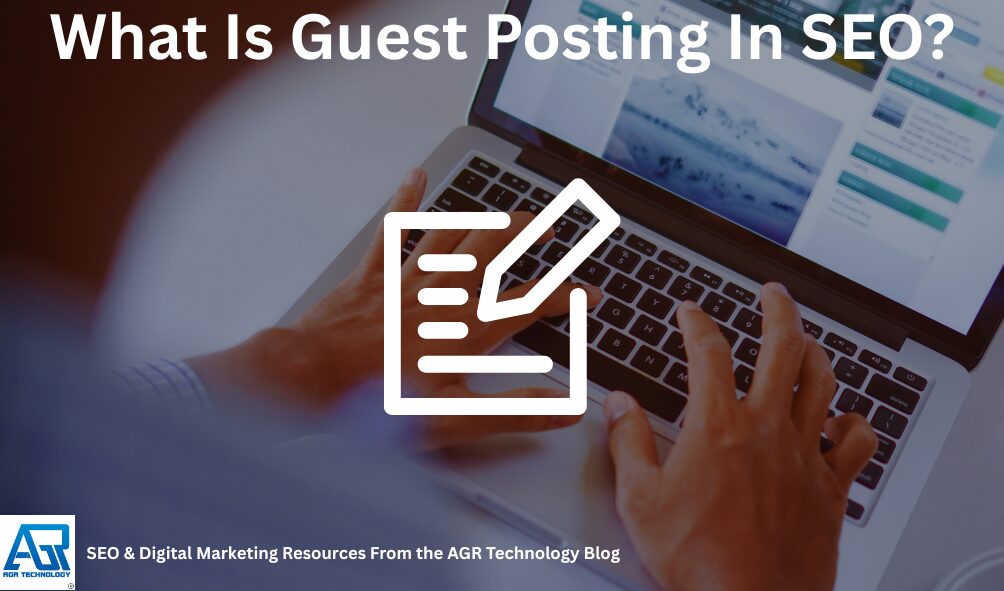If someone asks, “what is guest posting SEO?” they’re really asking how brands win attention and links beyond their own backyard. Guest posting is the practice of writing articles for other websites to earn high-quality backlinks, expand reach, and drive referral traffic. Done well, it’s a legit off-page SEO strategy that pairs helpful content with smart link placement, no gimmicks, no gray-hat tricks. This guide breaks down how it works, what to avoid, and a clean workflow that actually moves the needle.
Definition And How Guest Posting Works

Guest posting is when an author contributes content to an external, relevant site and (usually) includes one or two links back to their own pages. The host gets fresh, valuable content: the guest author earns exposure, referral traffic, and link equity, those “votes of confidence” that help search engines trust a site.
Here’s the simple flow:
- Identify reputable publishers in your niche.
- Pitch a topic aligned with the publisher’s audience.
- Write a value-first article.
- Add natural, contextual links to your most relevant resources.
- Submit, publish, and promote.
Two places links generally appear: within the article body or in the author bio. Contextual in-body links typically carry more weight because they’re embedded in the substance of the content, surrounded by semantically related text.
Guest Blogging vs. Contributor Content vs. Sponsored Posts
- Guest blogging: One-off or occasional expert articles focused on editorial value and knowledge-sharing.
- Contributor content: Ongoing columns or repeat contributions. Expect higher standards, editorial reviews, and stricter linking policies.
- Sponsored posts: Paid placements. These require proper disclosure and the correct rel attributes (usually rel=”sponsored”), and the content still needs to benefit readers to be worth it.
Where Links Typically Appear And How They’re Valued
- In-body, contextual links: Strongest signal when they’re relevant, add depth, and point to credible resources.
- Author bio links: Useful for brand discovery and referral traffic but usually pass less ranking value.
- Avoid: Sidebar/blogroll-style links and any irrelevant, shoehorned anchors. Search engines discount or distrust patterns that look manipulative.
SEO Benefits And When To Use Guest Posting
Guest posting works best when the goal is long-term authority, not quick hacks. It’s especially effective for new domains, brands entering a new category, and companies with expertise that isn’t yet recognized by search engines.
Authority Building, Mentions, And E-E-A-T Signals
Publishing on authoritative sites showcases experience and expertise. Those editorial endorsements, links, brand mentions, and author bylines, contribute to stronger E-E-A-T signals. In practice, consistent publishing on reputable sites can lift organic visibility significantly: many teams see a organic traffic increase within about six months when they secure high-authority placements and maintain quality.
Referral Traffic, Audience Growth, And Lead Gen
Beyond rankings, guest posts send targeted referral traffic. If the topic–audience fit is tight, readers click through, subscribe, and sometimes buy. Lead magnets, free tools, or case studies linked contextually can compound the effect.
Brand Partnerships And Networking Advantages
Every accepted post is a foot in the door with editors, site owners, and other contributors. Those relationships often lead to co-marketing, podcast invites, social amplification, and even product partnerships. In other words, the link is great: the network is better.
Risks, Myths, And Google’s Guidelines
Guest posting is safe and effective when it’s editorial-first. It becomes risky when links are the only goal.
What Counts As Manipulative Link Building
- Keyword-stuffed anchors (e.g., repeating exact-match phrases unnaturally)
- Irrelevant placements (finance site linking to casino content, etc.)
- Mass-produced, low-quality articles or PBNs
- Transactional link schemes (pay-to-post without proper disclosure, or swapping links excessively)
If it looks like it’s only for links, search engines will eventually treat it that way.
Nofollow, Sponsored, And Dofollow: When To Use Each
- rel=”sponsored”: For paid placements or anything with compensation.
- rel=”nofollow”: When the host won’t vouch for the link or the content is user-generated/untrusted.
- Dofollow (no rel attribute): For editorial, value-driven links that the publisher stands behind.
Using the correct attribute protects both parties and aligns with search engine policies.
“Guest Posting Is Dead” And Other Misconceptions
Guest posting isn’t dead, spammy guest posting is. When the content is strong, the link contextually relevant, and the publisher reputable, guest contributions remain one of the most durable off-page SEO tactics.
A Simple, Ethical Guest Posting Workflow
The best guest posting programs look less like “outreach blasts” and more like editorial partnerships.
Find Relevant, High-Quality Publishers
Look for sites with:
- Audience overlap (topics and intent match yours)
- Editorial guidelines and real bylines
- Healthy organic traffic and engagement
- Clean backlink profiles
A quick sniff test: Would you be proud to show this placement to customers?
Craft A Targeted Pitch With Clear Value
Skip the generic “I want to contribute” email. Propose 2–3 specific headlines and 1–2 sentence abstracts showing what readers will learn and why it fits the publication. Include a line or two about your experience and link to a couple of best-in-class samples.
Write Value-First Content With Natural, Relevant Links
- Lead with original insights, examples, and data.
- Place 1–2 backlinks where they genuinely help the reader, think how-to guides, research pages, or case studies.
- Keep anchors natural (e.g., “this technical SEO checklist” instead of “best technical SEO checklist 2025”).
Promote, Engage, And Build Ongoing Relationships
After publishing, share it widely, answer comments, and thank the editor. Offer a follow-up idea tailored to audience feedback. A steady cadence with a handful of top publishers beats one-off posts on dozens of random sites.
Best Practices For Links, Anchors, And On-Page SEO
Small editorial choices add up to big SEO outcomes.
Relevance Over Exact-Match Anchors
Use anchors that read naturally in context. Vary phrasing across posts. If the page is about enterprise analytics, an anchor like “advanced analytics setup” is safer and clearer than repeating the exact keyword.
Link Placement, Caps, And Disclosure Etiquette
- 1–2 backlinks to your site per post is a good ceiling.
- Prefer in-body placements near sections that discuss the linked topic.
- Disclose any sponsorship transparently, and ensure rel attributes match the relationship.
Optimize Headlines, Structure, And Internal Links
- Headlines: Promise a clear outcome and include a focus keyword where it fits.
- Structure: Use logical subheads, short paragraphs, bullets, and visuals for readability.
- Internal links (on the host site): Suggest helpful internal references to strengthen the article’s topical depth and user experience.
Measuring Impact And Iterating
If it isn’t measured, it doesn’t mature. Track both leading and lagging indicators.
Track Links, Traffic, Rankings, And Assisted Conversions
- Backlinks: Monitor new links, their authority, and indexation.
- Referral traffic: Use analytics to see sessions, time on page, and conversions from host domains.
- Rankings: Watch target keyword movements for linked pages and related terms.
- Assisted conversions: Attribute influence across touchpoints, not just last-click.
Evaluate Topic Fit, Publisher Quality, And Win Rates
Which posts actually sent qualified traffic or improved rankings? Which publishers edited well, promoted content, and engaged their audience? Track outreach-to-acceptance rates and average time-to-publish to prioritize partners that deliver.
Refine Outreach, Content Themes, And Cadence
Double down on topics that generate links and engagement. Retire pitches with low acceptance. Aim for a sustainable pace, e.g., 2–4 high-quality placements per month, so quality never slips.
Conclusion
Guest posting, at its best, is slow-burn authority building: publish excellent content on reputable sites, earn relevant links, and show up for new audiences. For anyone still wondering “what is guest posting SEO,” the answer is simple: it’s an ethical, value-first way to earn visibility off-site. The formula is straightforward, target the right publishers, pitch real ideas, write for readers, disclose relationships properly, and measure what matters. Do that consistently, and guest posting becomes a durable growth channel rather than a one-off tactic.
Need help with SEO, Guestposts and more for your business? Get in touch with AGR Technology to see how we can help
Key Takeaways
- Guest posting SEO is a value-first off-page strategy where you publish on relevant external sites to earn high-quality, contextual backlinks, reach new audiences, and drive referral traffic.
- Follow a simple workflow: find reputable publishers, pitch tailored topics, write a helpful article, add natural in-body links to relevant resources, then publish and promote.
- High-authority placements can strengthen E-E-A-T and often lift organic traffic 20–30% in about six months while sending qualified referrals and building valuable editor and partner relationships.
- Avoid manipulative link building by keeping anchors natural and relevant, and use correct link attributes—rel=”sponsored” for paid, rel=”nofollow” when unvouched, and dofollow for true editorial.
- Cap at 1–2 backlinks per post, prefer in-article contextual links, optimize headlines and structure, and measure impact via backlinks, referral traffic, rankings, and assisted conversions to refine topics, publishers, and cadence.
Frequently Asked Questions
What is guest posting SEO and how does it work?
Guest posting SEO is the practice of publishing articles on relevant external sites to earn contextual backlinks, referral traffic, and brand exposure. You pitch a topic, write a value-first article, and include 1–2 natural, relevant links. High-quality placements build authority, trust, and long-term organic visibility.
Where should I place links in a guest post for the best SEO value?
Prioritize in-body, contextual links that add depth at the exact point a resource helps the reader—these typically carry the strongest signal in guest posting SEO. Use natural anchors, avoid exact-match stuffing, and cap self-links at 1–2. Author bio links aid discovery but usually pass less ranking value.
What’s the difference between guest blogging, contributor content, and sponsored posts?
Guest blogging is usually a one-off expert article focused on editorial value. Contributor content is ongoing, with higher standards and stricter linking policies. Sponsored posts are paid placements that require clear disclosure and rel=”sponsored”. All should help readers; only editorial links without compensation merit dofollow treatment.
How long does guest posting SEO take to show results?
Expect a slow-burn payoff. With consistent, high-authority placements and quality content, many teams see organic traffic growth within about six months. Track backlinks, referral traffic, keyword movements, and assisted conversions to gauge progress and refine topics, publishers, and cadence over time.
How do I find sites that accept guest posts in my niche?
Combine footprint searches (e.g., “site:example.com guest post guidelines,” “write for us + topic”), social/X and LinkedIn editor calls, and competitor backlink analysis in tools like Ahrefs or Semrush. Prioritize publishers with audience overlap, editorial guidelines, real bylines, and healthy organic traffic and engagement.
How do I evaluate publisher quality before pitching?
Check topical relevance, audience intent match, and editorial standards. Assess organic traffic trends (e.g., via Similarweb), backlink quality, and on-site engagement. Review past contributors and how content is promoted. If compensation is involved, ensure proper disclosure and rel attributes to stay compliant and protect your site.
Related resources:

Alessio Rigoli is the founder of AGR Technology and got his start working in the IT space originally in Education and then in the private sector helping businesses in various industries. Alessio maintains the blog and is interested in a number of different topics emerging and current such as Digital marketing, Software development, Cryptocurrency/Blockchain, Cyber security, Linux and more.
Alessio Rigoli, AGR Technology
![logo-new-23[1] logo-new-23[1]](https://agrtech.com.au/wp-content/uploads/elementor/thumbs/logo-new-231-qad2sqbr9f0wlvza81xod18hkirbk9apc0elfhpco4.png)
